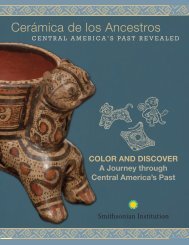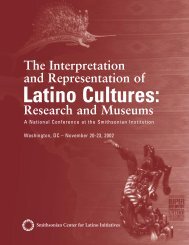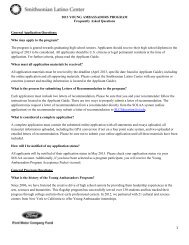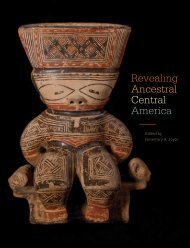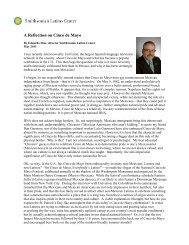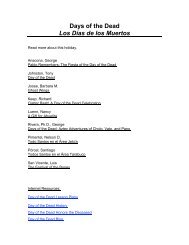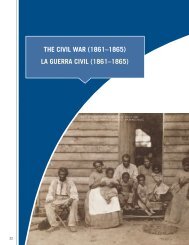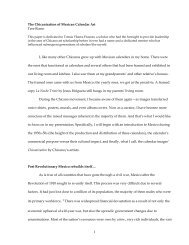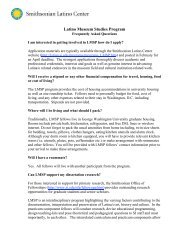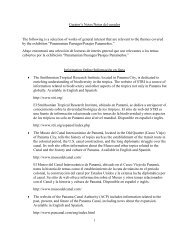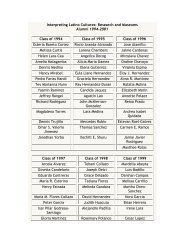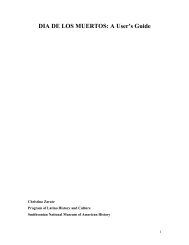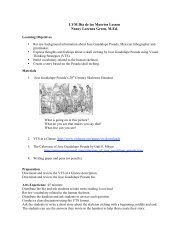smithsonian latino art collections - Smithsonian Latino Center
smithsonian latino art collections - Smithsonian Latino Center
smithsonian latino art collections - Smithsonian Latino Center
You also want an ePaper? Increase the reach of your titles
YUMPU automatically turns print PDFs into web optimized ePapers that Google loves.
Among progress the Oversight Committee cited <strong>Latino</strong>s in senior management positions; the<br />
<strong>Latino</strong> Initiatives Pool; the work of the National Museum of American Art (present-day SAAM) with its<br />
educational programs; and the <strong>Latino</strong> Graduate Training Seminar (co-sponsored by the <strong>Smithsonian</strong>’s<br />
<strong>Center</strong> for Museum Programs and IUPLR). However, as limited progress, it identified a gain of only 15<br />
new <strong>Latino</strong> employees from 1994 to 1995; the lack of an Equal Opportunity Employment process and<br />
oversight; little support for a <strong>Latino</strong> Museum on the National Mall due to budgetary and political<br />
constraints at the time; no understanding of changing demographics in the U.S. and the growing U.S.<br />
<strong>Latino</strong> population; and the prevalent conflation in the Institution of Latin America with U.S. <strong>Latino</strong>s or as<br />
the interim report put it, the “approach of the <strong>Latino</strong> experience from the ‘outside in’ beginning with<br />
Latin America rather than the U.S.” 71<br />
Concurrent with the Oversight Committee, Secretary Heyman also appointed an internal <strong>Latino</strong><br />
Program Planning Committee on October 9, 1996 to “design a <strong>Smithsonian</strong>-wide response to the need<br />
for a wider infusion of <strong>Latino</strong> perspectives in all aspects of its programming, and to quicken the pace of<br />
change,” 72 with initiatives at a near term (1997-1998) and at a mid-term (1999-2000) for the institution’s<br />
programs to integrate <strong>Latino</strong> contributions to US culture and heritage. Members of the Planning<br />
Committee included <strong>Smithsonian</strong> Executives and Directors among them J. Dennis O’Connor, Chair<br />
(Provost, <strong>Smithsonian</strong> Institution); Miguel Bretos (Counselor to the Secretary for Community Affairs);<br />
Elizabeth Broun (Director, National Museum of American Art); Alice Greene Burnette (Assistant<br />
Secretary for Institutional Advancement); Anna Cohn (Director, <strong>Smithsonian</strong> Institution Traveling<br />
Exhibition Service); Spencer Crew (Director, National Museum of American History); Francisco Gómez<br />
Dallmeier (Director, Man and the Biosphere Program); Robert Fri (Director, National Museum of Natural<br />
History); Richard Kurin (Director, <strong>Center</strong> for Folklife Programs and Cultural Studies); Donald Lopez<br />
(Deputy Director, National Air and Space Museum) and Mara Mayor (Director, The <strong>Smithsonian</strong><br />
Associates).<br />
This internal committee outlined four areas of focus: a central <strong>Latino</strong> presence, unit-based<br />
initiatives, external collaborations and affiliations, and funding and staffing. The central <strong>Latino</strong> presence<br />
was conceived as a pan-institutional <strong>Latino</strong> center “to provide a coordinating mechanism and a paninstitutional<br />
focus to <strong>Smithsonian</strong>’s <strong>Latino</strong> initiatives…[utilizing as] possible model…the <strong>Center</strong> for<br />
African-American History and Culture, combining an internal coordinating function, research<br />
sponsorship (including internships and fellowships), linkages with outside organizations, public outreach,<br />
and exhibitions.” 73 To that effect, Provost O’Connor appointed a planning group to make<br />
recommendations of the structure and funding of a center to him by April 15, 1997. 74 Unit-based<br />
initiatives included exhibitions, collection development, conferences and seminars, intenships and<br />
fellowships and the use of New Media developed by each unit. External collaborations and affiliations,<br />
per the 1996 Regents’ “Policy on Affiliations” sought to establish strategic p<strong>art</strong>nerships and<br />
collaborations for the Institution to connect with the American people beyond the confines of the<br />
National Mall by utilizing electronic communications and media and creating a structured program for<br />
Archives, SIA AH00394, <strong>Smithsonian</strong> Institution Office of the Secretary Counselor to the Secretary for Community<br />
Affairs and Special Projects, Agency History, 1994-1995.<br />
71 Ibid. pp. 5-7.<br />
72 Report of the <strong>Latino</strong> Program Planning Committee, 1997, p. 2. Provided to author by Miguel A. Bretos.<br />
73 Ibid. p. 3.<br />
74 Members of the planning group included Miguel Bretos (Office of the Secretary), Elizabeth Broun (NMAA),<br />
Andrew Connors (NMAA), Spencer Crew (NMAH), Olivia Cadaval (<strong>Center</strong> for Folklife and Cultural Studies), Rex Ellis<br />
(<strong>Center</strong> for Museum Studies), Liza Kirwin (Archives of American Art), Richard Kurin (<strong>Center</strong> for Folklife and Cultural<br />
Studies), Steven Newsome (Anacostia), Marvette Perez (NMAH), Olga Viso (HMSG) and Rick West (NMAI). Ibid.<br />
20



